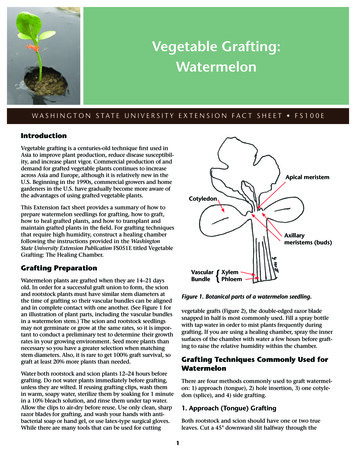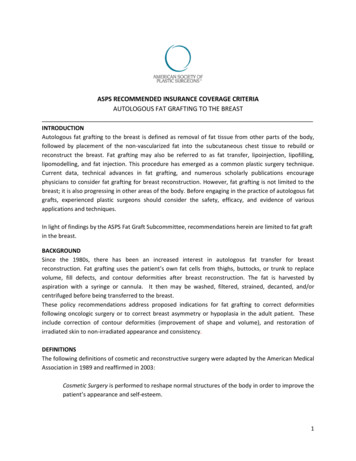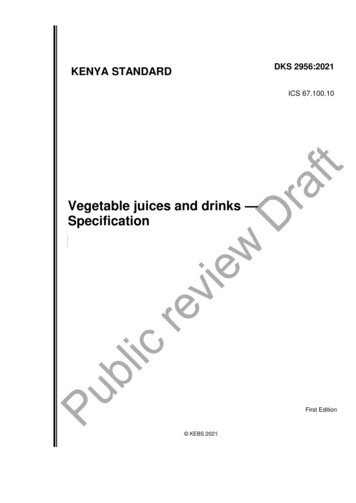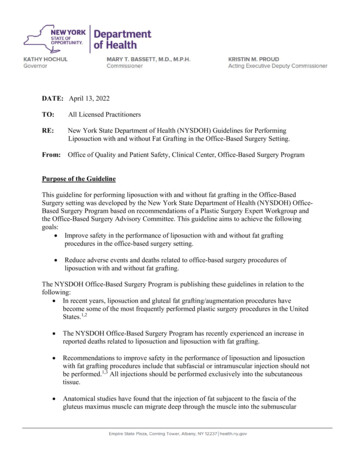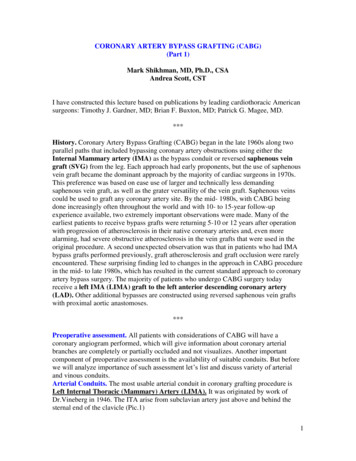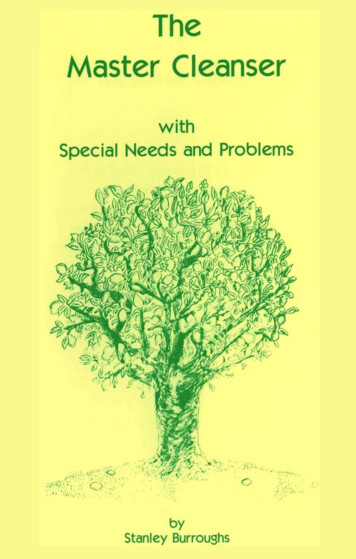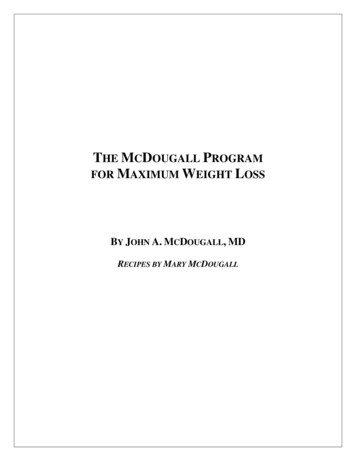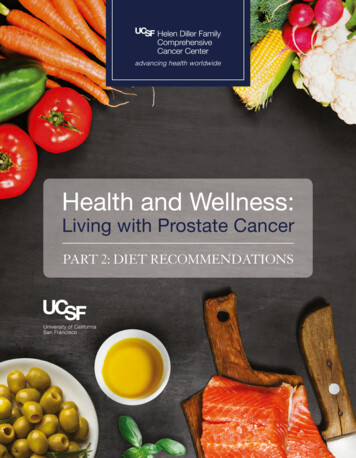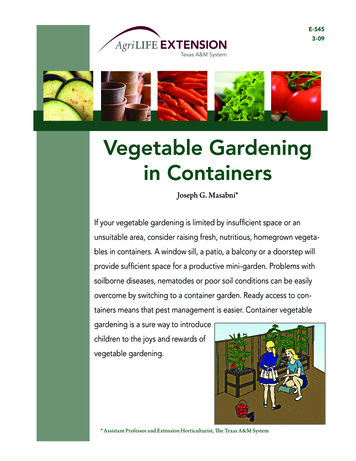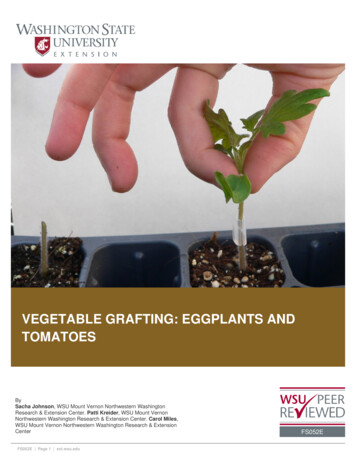
Transcription
VEGETABLE GRAFTING: EGGPLANTS ANDTOMATOESBySacha Johnson, WSU Mount Vernon Northwestern WashingtonResearch & Extension Center. Patti Kreider, WSU Mount VernonNorthwestern Washington Research & Extension Center. Carol Miles,WSU Mount Vernon Northwestern Washington Research & ExtensionCenterFS052E Page 1 ext.wsu.eduFS052E
WSU EXTENSION VEGETABLE GRAFTING: EGGPLANTS AND TOMATOESVegetable Grafting: Eggplants and TomatoesVegetable grafting is a centuries-old technique utilized in Asiato improve plant production, reduce disease susceptibility, andincrease plant vigor. Commercial production and demand forgrafted vegetable plants continues to increase across Asia andEurope. Vegetable grafting was introduced in the United Statesalmost 20 years ago and commercial growers and homegardeners are becoming more aware of its attributes andpotential to manage soil-borne diseases and adverse soilconditions.more information on healing chamber construction andmanagement). Use only clean, sharp razor blades and sanitizehands with antibacterial soap or hand gel. Fill one or two spraybottles with tap water to mist plants frequently during grafting.This fact sheet provides brief descriptions of how to prepareplant material for grafting, some general considerations forgrafting, the most common techniques used to graft eggplantand tomato, healing grafted plants, and transplanting andmaintaining grafted plants in the field. Each grafting techniquehas several different names, so for clarity, here we use themost common name for each technique. Also included is astep-by-step process for grafting both eggplant and tomatousing the splice grafting technique.The Grafting ProcessSplice grafting is the most commonly used grafting method foreggplant and tomato because it has a high success rate (95%),is relatively simple, and can be used to graft a large number ofplants in a short amount of time. Deciding which graftingtechnique to use depends on the number of plants, their size atthe time of grafting, the feasibility of using special graftingclips, and personal preference.Once you are comfortable with the grafting process, you cancut multiple rootstocks and scions at one time to speed up theprocess; cutting all seedlings in one flat (72-cell trays) is agood number to work with at one time. Discard rootstock topsimmediately to minimize confusion. Mist all plants with waterfrequently to reduce water stress. After you have finishedgrafting a flat of plants, place it immediately in a healingchamber.Preparing for GraftingFor a successful graft union to form, the cambium of therootstock and scion must be well aligned and in contact withone another. The scion and rootstock plants must thereforehave similar stem diameters at the time of grafting. However,the scion and rootstock may not germinate or grow at the samerate. Conduct a preliminary trial to determine the growth ratesof rootstock and scion plants in your growing environment.Based on the results, seed both scion and rootstock varieties sothat they are ready for grafting in 14–21 days. Seed moreplants than necessary so that you have a greater selection formatching stem diameters. It is rare to get 100% graft survival,so it is always recommended to graft additional plants toaccount for some graft failure.Water both rootstock and scion plants 12–24 hours beforegrafting. Unless absolutely necessary, do not water plantsimmediately before grafting. If reusing grafting clips, makesure they have been cleaned and sterilized. A few hours beforegrafting, spray the inner healing chamber surfaces with waterto raise the relative humidity within the chamber (see“Vegetable Grafting: The Healing Chamber,” FS051E, forFS052E Page 2 ext.wsu.eduPlants are ready for grafting when they have 2–4 true leaves.Graft during a time of day when plant transpiration is lowest,such as early in the morning, to minimize water stress in thenewly grafted plants.Cut the rootstock stem below the cotyledons to prevent it fromproducing new shoot growth. Select a scion with a stemdiameter that matches the rootstock stem diameter and cuthere. The entire cut surfaces of both scion and rootstock stemsshould be in close contact so that air is not trapped betweenthem. If the cut surface of the scion or the rootstock dries out,the graft will fail.Cleft GraftingAlso known as apical grafting and wedge grafting.Technique. Cut the rootstock stem horizontally to remove thetop of the plant and discard the top (Figure 1). Cut a 0.5 cmlong vertical incision into the center of the rootstock. Cut thescion stem into a 0.5 cm long wedge and insert it into thevertical incision in the rootstock. Place a plastic clip orparafilm around the graft union to hold it tightly together.Advantages. The cleft (vertical) cut holds the scionmore tightly than splice grafting, so it is possible to useparafilm rather than grafting clips to secure the graftunion.Disadvantages. This technique takes more time thansplice grafting. The rootstock stem may split if thescion wedge is too wide.
WSU EXTENSION VEGETABLE GRAFTING: EGGPLANTS AND TOMATOESSide GraftingAlso known as tongue approach grafting and side-by-sidegrafting.Technique. Cut matching 45 incisions in scion and rootstockstems, approximately ¾ through the stem, to create “tongues”(Figure 2). Join the stem tongues together so that the cutsurfaces are in contact. Wrap parafilm tightly around the graftunion to prevent moisture loss. After 5 days, begin to sever therootstock top and the scion roots from the grafted plant suchthat the two are completely separated within 3 days.Advantages. This technique has a high success rate. It isless stressful on the plant than other graftingtechniques, as the scion is able to absorb water throughits root system during the healing process. Highhumidity is not required to heal grafts, so a healingchamber, although recommended, is not necessary.Larger plant material can be used, and stems can haveslightly different diameters.Disadvantages. The rootstock and scion must betransplanted together into a larger container at the timeof grafting, which requires more greenhouse space.This technique is slower and slightly more difficult thansplice grafting or cleft grafting. The scion and rootstockcan get confused and should be labeled if they looksimilar so that the graft does not end up with therootstock variety on top and the scion variety on thebottom.Figure 1. Cleft grafting.Figure 2. Side grafting.FS052E Page 3 ext.wsu.edu
WSU EXTENSION VEGETABLE GRAFTING: EGGPLANTS AND TOMATOESFigure 3. Splice grafting of tomato plants. Cutting tomato stem at a 45º angle (A) and using a clip to secure the scion to the rootstock (B).Healing the Grafted PlantsFigure 4. Silicon grafting clips used in splice grafting eggplant and tomato.Splice GraftingAlso known as top grafting, tube grafting, and slant-cutgrafting. This is the most widely used grafting technique fortomatoes and also works well for eggplants.Technique. Cut the rootstock and scion at matching 45 anglesand clip together with a silicone grafting clip (Figures 3 and 4).Advantages. Easy technique to learn, and a fast way tograft large quantities of plants.Disadvantages. Grafting clips are required to hold thescion and rootstock in close contact.When placing newly grafted plants in a healing chamber, mistthe inside walls and top of the healing chamber surfaces verywell. Seal the healing chamber and do not disturb for 2 days.On day 3 after grafting, open the healing chamber just enoughto spray inside the plastic with water to raise the humidity, andclose again. Water collecting at the graft union can lead todisease, necrotic tissue, and graft failure. If these symptomsare observed, avoid misting plants directly. Do not disturb thehealing chamber on day 4. On day 5, open the healing chamberfor 30 minutes, then spray plastic surfaces and close thechamber. On day 6, open the healing chamber for one hour,then spray the healing chamber well and close tightly. On day7, open the healing chamber for 6–8 hours, then spray thehealing chamber and close tightly. On day 8, remove the plantsfrom the healing chamber.This healing schedule is based on the greenhouse graftingenvironment at Washington State University Mount VernonNorthwest Washington Research & Extension Center. Yourgreenhouse or grafting environment may be different (higheror lower humidity and temperature), and you may need toadjust the exposure times for grafted plants so that they are notstressed when introducing them back into the greenhouseenvironment. The key is to slowly acclimatize the graftedplants without causing permanent wilting which will lead toplant death.Transplanting into the FieldAlthough the scion and rootstock establish vascular connectionat approximately 7 days, it takes at least 14 days from graftingfor the graft union to fully heal. After removing plants fromthe healing chamber, allow them to rest in the greenhouse forFS052E Page 4 ext.wsu.edu
WSU EXTENSION VEGETABLE GRAFTING: EGGPLANTS AND TOMATOES1–2 days before hardening them off for 5–7 days beforetransplanting. Adjust this schedule if needed so as to not stressplants when introducing them into the field environment.Do not place grafted transplants into the field under windyconditions. If wind is an issue in your area, leave the siliconegrafting clips on the plant for a few weeks to provide support.You may also remove the clips at transplanting and wrap thegraft union with parafilm to provide extra support. Parafilmwill break away from the stem as the stem increases indiameter. Similarly, silicone grafting clips will fall off as thestem increases in diameter. Collect the grafting clips, and cleanand sterilize them before you use them again.When transplanting, make sure that the graft union remainsabove the soil line. If the graft union is buried, the scion willroot into the soil and any advantages that would have beenprovided by the rootstock, such as resistance to soil-bornediseases, will be nullified.Field Maintenance of GraftedPlantsRemove any remaining grafting clips 2–3 weeks after fieldtransplanting. Check the plants at least once a week to see ifthe rootstock has regrown and remove it immediately. Manycommercial rootstocks are extremely vigorous and will quicklyovertake the scion variety.FS052E Page 5 ext.wsu.edu
WSU EXTENSION VEGETABLE GRAFTING: EGGPLANTS AND TOMATOESCopyright 2011 Washington State UniversityWSU Extension bulletins contain material written and produced for public distribution. Alternate formats of our educationalmaterials are available upon request for persons with disabilities. Please contact Washington State University Extension for moreinformation.Issued by Washington State University Extension and the U.S. Department of Agriculture in furtherance of the Acts of May 8 andJune 30, 1914. Extension programs and policies are consistent with federal and state laws and regulations on nondiscriminationregarding race, sex, religion, age, color, creed, and national or ethnic origin; physical, mental, or sensory disability; marital statusor sexual orientation; and status as a Vietnam-era or disabled veteran. Evidence of noncompliance may be reported through yourlocal WSU Extension office. Trade names have been used to simplify information; no endorsement is intended. Published October2011.FS052E Page 6 ext.wsu.edu
When placing newly grafted plants in a healing chamber, mist the inside walls and top of the healing chamber surfaces very well. Seal the healing chamber and do not disturb for 2 days. On day 3 after grafting, open the healing chamber just enough to spray inside the plastic with water to raise the humidity, and close again.
